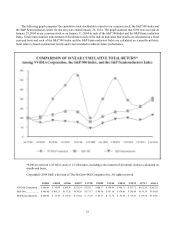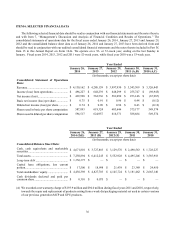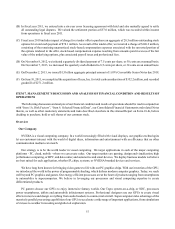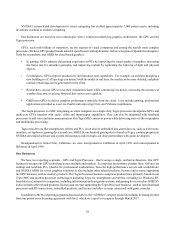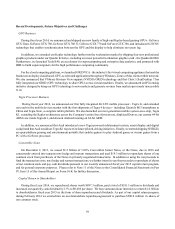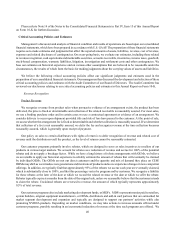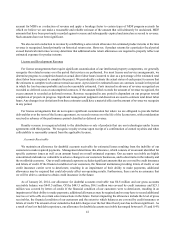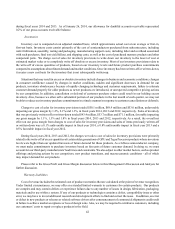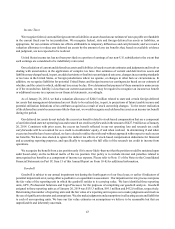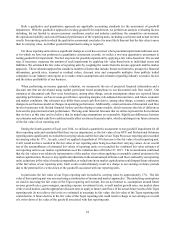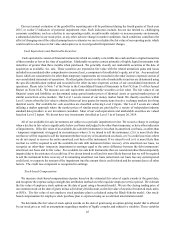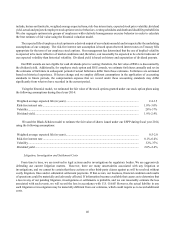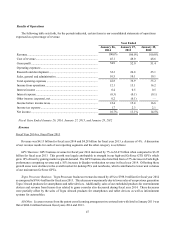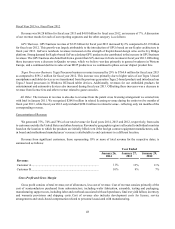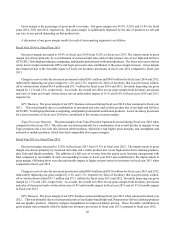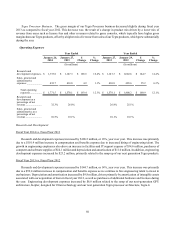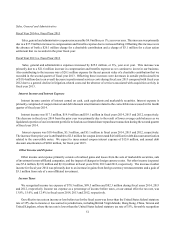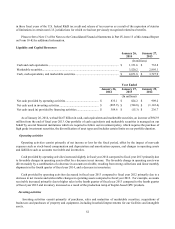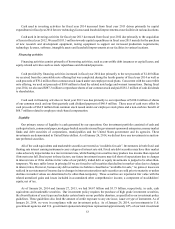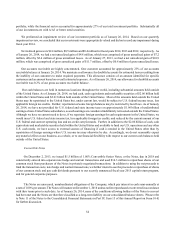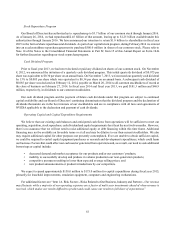NVIDIA 2013 Annual Report Download - page 189
Download and view the complete annual report
Please find page 189 of the 2013 NVIDIA annual report below. You can navigate through the pages in the report by either clicking on the pages listed below, or by using the keyword search tool below to find specific information within the annual report.45
Our next annual evaluation of the goodwill by reporting unit will be performed during the fourth quarter of fiscal year
2015, or earlier if indicators of potential impairment exist. Such indicators include, but are not limited to, challenging
economic conditions, such as a decline in our operating results, an unfavorable industry or macroeconomic environment,
a substantial decline in our stock price, or any other adverse change in market conditions. Such conditions could have the
effect of changing one of the critical assumptions or estimates we use to calculate the fair value of our reporting units, which
could result in a decrease in fair value and require us to record goodwill impairment charges.
Cash Equivalents and Marketable Securities
Cash equivalents consist of financial instruments which are readily convertible into cash and have original maturities
of three months or less at the time of acquisition. Marketable securities consist primarily of highly liquid investments with
maturities of greater than three months when purchased. We generally classify our marketable securities at the date of
acquisition as available- for- sale. These securities are reported at fair value with the related unrealized gains and losses
included in accumulated other comprehensive income (loss), a component of stockholder’s equity, net of tax. Any unrealized
losses which are considered to be other-than-temporary impairments are recorded in the other income (expense) section of
our consolidated statements of operations. Realized gains (losses) on the sale of marketable securities are determined using
the specific-identification method and recorded in the other income (expense) section of our consolidated statements of
operations. Please refer to Note 7 of the Notes to the Consolidated Financial Statements in Part IV, Item 15 of this Annual
Report on Form 10-K. We measure our cash equivalents and marketable securities at fair value. The fair values of our
financial assets and liabilities are determined using quoted market prices of identical assets or quoted market prices of
similar assets from active markets. Our Level 1 assets consist of our money market funds. We classify securities within
Level 1 assets when the fair value is obtained from real time quotes for transactions in active exchange markets involving
identical assets. Our available-for- sale securities are classified as having Level 2 inputs. Our Level 2 assets are valued
utilizing a market approach where the market prices of similar assets are provided by a variety of independent industry
standard data providers to our investment custodian. Most of our cash equivalents and marketable securities are valued
based on Level 2 inputs. We do not have any investments classified as Level 3 as of January 26, 2014.
All of our available-for-sale investments are subject to a periodic impairment review. We record a charge to earnings
when a decline in fair value is significantly below cost basis and judged to be other-than-temporary, or have other indicators
of impairments. If the fair value of an available-for-sale debt instrument is less than its amortized cost basis, an other-than
- temporary impairment is triggered in circumstances where (1) we intend to sell the instrument, (2) it is more likely than
not that we will be required to sell the instrument before recovery of its amortized cost basis, or (3) a credit loss exists where
we do not expect to recover the entire amortized cost basis of the instrument. If we intend to sell or it is more likely than
not that we will be required to sell the available-for-sale debt instrument before recovery of its amortized cost basis, we
recognize an other-than- temporary impairment in earnings equal to the entire difference between the debt instruments’
amortized cost basis and its fair value. For available-for-sale debt instruments that are considered other-than-temporarily
impaired due to the existence of a credit loss, if we do not intend to sell and it is more likely than not that we will be required
to sell the instrument before recovery of its remaining amortized cost basis (amortized cost basis less any current-period
credit loss), we separate the amount of the impairment into the amount that is credit related and the amount due to all other
factors. The credit loss component is recognized in earnings.
Stock-based Compensation
We measure stock-based compensation expense based on the estimated fair value of equity awards at the grant date,
and recognize the expense using a straight-line attribution method over the requisite employee service period. We estimate
the fair value of employee stock options on the date of grant using a binomial model. We use the closing trading price of
our common stock on the date of grant, minus a dividend yield discount, as the fair value of awards of restricted stock units,
or RSUs. The fair value of our employee stock purchase plan is calculated using the Black-Scholes model. Our stock-
based compensation for employee stock purchase plan is expensed using an accelerated amortization model.
We determine the fair value of stock option awards on the date of grant using an option-pricing model that is affected
by our stock price as well as assumptions regarding a number of highly complex and subjective variables. These variables


